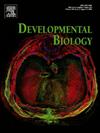The search to understand the development of the chicken immune system: Differences in expression of MHC class I loci and waves of thymocytes as evolutionary relics?
IF 2.5
3区 生物学
Q2 DEVELOPMENTAL BIOLOGY
引用次数: 0
Abstract
Chickens are renowned as a model for embryogenesis but have also been responsible for crucial advances in virology, cancer research and immunology. However, chickens are best known as a major source of animal protein for human nutrition, with roughly 80 billion chickens alive each year supplying meat and eggs, the vast majority part of a global poultry industry. As a result, avian immunology been studied intensively for over 60 years, and it has become clear that a major genetic locus in chickens determining resistance to infectious disease and response to vaccines is the major histocompatibility complex (MHC). Compared to typical mammals, the chicken MHC is compact and simple, with only two classical class I genes. A dominantly-expressed class I gene, BF2, is the major ligand for cytotoxic T lymphocytes (CTLs), while the other locus, BF1, is much less well-expressed, lacking in some MHC haplotypes, and is a ligand for natural killer (NK) cells. Cell surface class I expression in neonatal chicks is far less than in adults, and one possibility is that BF2 is not well-expressed early in ontogeny. A precedent is found for amphibians: the single classical class I molecule is not expressed in tadpoles of Xenopus frogs, although non-polymorphic (and thus non-classical) class I molecules from the XNC locus are expressed, which are recognised for immune defence by non-canonical NKT lymphocytes. Indeed, three waves of different T cells are produced by the Xenopus thymus: in tadpoles, during metamorphosis and finally as adults. Three waves of thymic emigrants are also found for chickens, and reasoning by analogy, it may be that the waves of thymocytes and the expression of class I molecules during ontogeny of chickens are evolutionary relics. As well as scientific interest in the ontogeny of MHC class I expression and appearance of peripheral T cells, there are potential practical implications, given the importance of vaccination in ovo and in day-old chicks for the poultry industry.
探索了解鸡免疫系统的发展:MHC I类位点的表达差异和胸腺细胞波作为进化遗迹?
鸡作为胚胎发生的模型而闻名,但在病毒学、癌症研究和免疫学方面也取得了重大进展。然而,众所周知,鸡是人类营养动物蛋白的主要来源,每年大约有800亿只活鸡供应肉和蛋,占全球家禽业的绝大部分。因此,禽类免疫学经过了60多年的深入研究,已经清楚地表明,鸡对传染病的抵抗力和疫苗反应的主要遗传位点是主要的组织相容性复合体(MHC)。与典型的哺乳动物相比,鸡的MHC结构紧凑而简单,只有两个经典的I类基因。一个显性表达的I类基因BF2是细胞毒性T淋巴细胞(ctl)的主要配体,而另一个基因座BF1表达得不太好,在一些MHC单倍型中缺乏,是自然杀伤(NK)细胞的配体。雏鸡细胞表面I类表达量远低于成鸡,一种可能是BF2在个体发育早期表达不佳。在两栖动物中发现了一个先例:尽管来自XNC位点的非多态性(因此是非经典的)I类分子被非典型的NKT淋巴细胞识别为免疫防御,但在爪蟾蛙的蝌蚪中不表达单一的经典I类分子。事实上,胸腺爪蟾会产生三波不同的T细胞:蝌蚪、变态和成年。在鸡身上也发现了三波胸腺迁移,通过类比推理,可能是鸡个体发育过程中胸腺细胞的迁移和I类分子的表达是进化的遗迹。除了对MHC I类表达的个体发生和外周T细胞外观的科学兴趣外,考虑到在蛋鸡和日龄鸡中接种疫苗对家禽业的重要性,还有潜在的实际意义。
本文章由计算机程序翻译,如有差异,请以英文原文为准。
求助全文
约1分钟内获得全文
求助全文
来源期刊

Developmental biology
生物-发育生物学
CiteScore
5.30
自引率
3.70%
发文量
182
审稿时长
1.5 months
期刊介绍:
Developmental Biology (DB) publishes original research on mechanisms of development, differentiation, and growth in animals and plants at the molecular, cellular, genetic and evolutionary levels. Areas of particular emphasis include transcriptional control mechanisms, embryonic patterning, cell-cell interactions, growth factors and signal transduction, and regulatory hierarchies in developing plants and animals.
 求助内容:
求助内容: 应助结果提醒方式:
应助结果提醒方式:


